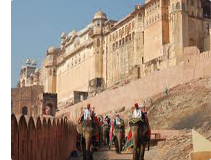Jaipur
 The city is unusual among pre-modern Indian cities in the regularity of its streets, and the division of the city into six sectors by broad streets 34 m (111 ft) wide. The urban quarters are further divided by networks of gridded streets. Five quarters wrap around the east, south, and west sides of a central palace quarter, with a sixth quarter immediately to the east. The Palace quarter encloses the Hawa Mahal palace complex, formal gardens, and a small lake. Nahargarh Fort, which was the residence of the King Sawai Jai Singh II, crowns the hill in the northwest corner of the old city. The observatory, Jantar Mantar, is one of the World Heritage Sites.Included on the Golden Triangle tourist circuit, along with Delhi and Agra, Jaipur is an extremely popular tourist destination in Rajasthan and India.
The city is unusual among pre-modern Indian cities in the regularity of its streets, and the division of the city into six sectors by broad streets 34 m (111 ft) wide. The urban quarters are further divided by networks of gridded streets. Five quarters wrap around the east, south, and west sides of a central palace quarter, with a sixth quarter immediately to the east. The Palace quarter encloses the Hawa Mahal palace complex, formal gardens, and a small lake. Nahargarh Fort, which was the residence of the King Sawai Jai Singh II, crowns the hill in the northwest corner of the old city. The observatory, Jantar Mantar, is one of the World Heritage Sites.Included on the Golden Triangle tourist circuit, along with Delhi and Agra, Jaipur is an extremely popular tourist destination in Rajasthan and India.
Climate :
Jaipur has a semiarid climate under the Köppen climate classification, receiving over 650 millimetres (26 in) of rainfall annually but most rains occur in the monsoon months between June and September. Temperatures remain relatively high throughout the year, with the summer months of April to early July having average daily temperatures of around 30 °C (86 °F). During the monsoon there are frequent, heavy rains and thunderstorms, but flooding is not common. The winter months of November to February are mild and pleasant, with average temperatures ranging from 15-18 °C (59-64 °F) and with little or no humidity. There are however occasional cold waves that lead to temperatures near freezing.
Forts and monuments :
Jaipur has a number of forts and monuments like
- Hawa Mahal
- Amer Fort
- Jaigarh Fort
- Nahargarh Fort
- City Palace
- Jantar Mantar
- Jal Mahal
- Rambagh Palace
- Albert Hall Museum.
Temples and places for worship :
Jaipur has numerous temples and religious places. It is because of the numerous temples that it is sometimes also known as Chhoti Kashi. Some of the famous temples in Jaipur include
- Govind Dev Ji Temple
- Galtaji
- Lakshmi Narayan Mandir commonly known as Birla Temple
- Garh Ganesh Temple
- Panchayati Hall
- Sri Sri Krishna Balram Temple, jagatpura
- Moti Dungri Ganesh Mandir











 Manali
Manali

